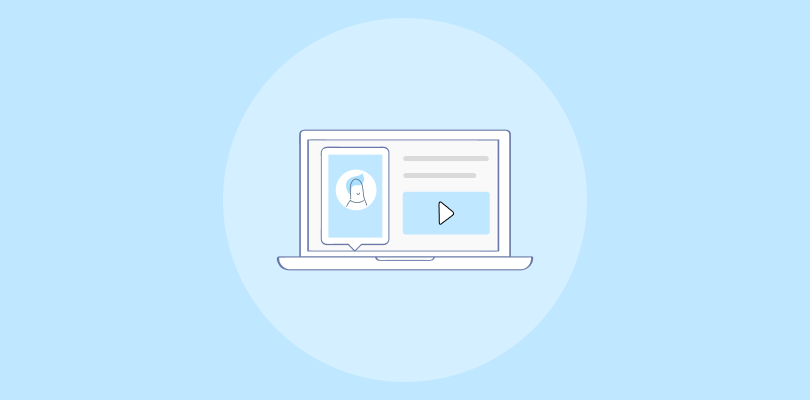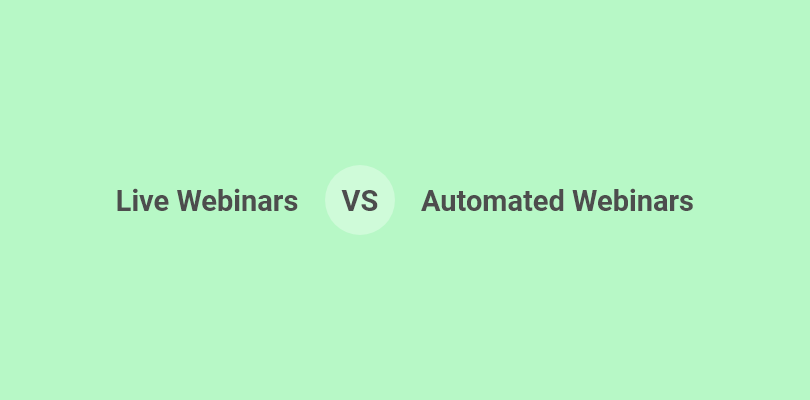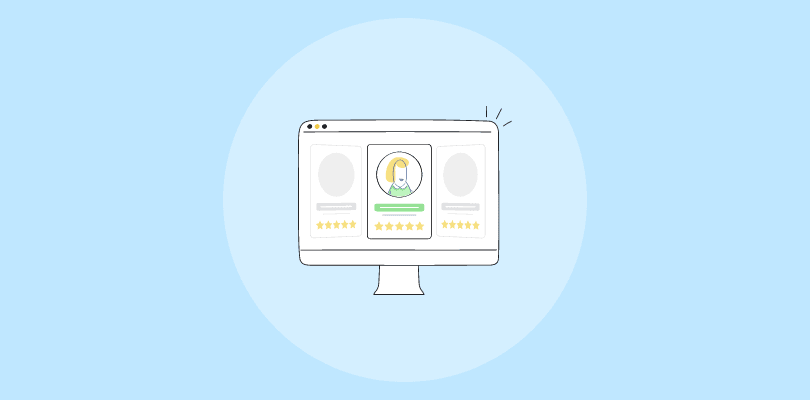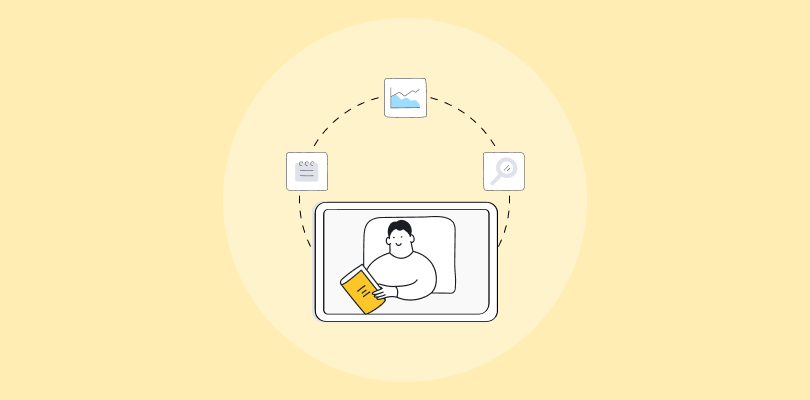Yesterday, I saw my neighbor watching a video while walking his dog🐶. When asked, he said it was an expert pre-recorded webinar on “how to walk your dog effectively.” 😂
Funny, right?
But that got me thinking about the magic of pre-recorded webinars, which deliver great results without juggling schedules or time zones. Imagine effortlessly reaching a global audience🌍 or allowing attendees to learn at their own pace.
In fact, with nearly a decade in the webinar industry, I’ve seen these sessions gain immense popularity. However, creating a pre-recorded webinar that truly engages requires a unique approach, distinct from live events.📽️
Curious about how to make the most of them? 🤔
Here’s a detailed guide to help you discover how to leverage pre-recorded webinars for maximum impact.
Let’s dive deeper:
What is a Pre-Recorded Webinar?
A pre-recorded webinar is a webinar that is recorded in advance and made available for on-demand viewing. Unlike live webinars, pre-recorded webinars allow presenters to deliver their content without the constraints of real-time interaction.
This format offers flexibility to viewers, who can access the material at their convenience, and to presenters, who can reach a wider audience without scheduling conflicts. Presenters can also edit and refine the webinars for clarity and quality.
Pre-recorded webinars can cover various topics and are often used for training, education, marketing, and information dissemination.
What Are the Types Of Pre-Recorded Webinars?
Let’s explore the different formats pre-recorded webinars can take to meet your specific needs:
1. Automated Webinars
These are pre-recorded webinars scheduled to run without the host needing to be present. They often include pre-programmed interactions, like polls or quizzes, to keep the audience engaged.
- When to Use: This is ideal for regular content delivery, such as training sessions or product demonstrations, where consistency and automation are key.
- How to Use: Set up the webinar recording, including your presentation and desired interactive elements. Schedule it to run automatically at designated times.
- Why Use It: Saves time and resources by automating repetitive tasks, allowing you to focus on other aspects of your content strategy. It also ensures consistent delivery of your message.
2. On-Demand Webinars
These interactive presentations are available instantly upon registration. Attendees can watch the webinar at their own pace and convenience.
- When to Use: When you want to provide immediate access to valuable content, such as educational tutorials or product demos.
- How to Use: Make the webinar recording available on your website or landing page after registration.
- Why Use It: Offers flexibility to the audience, removes friction in content delivery, and allows viewers to revisit the information as needed.
3. Evergreen Webinars
This type of pre-recorded webinar remains relevant over time and can be accessed repeatedly. They’re ideal for topics that don’t require frequent updates.
- When to Use: For timeless content that offers lasting value, such as industry overviews or core company principles.
- How to Use: Record the webinar focusing on topics with long-term value and minimal need for updates.
- Why Use It: Maximizes the lifespan and ROI of your webinar by allowing viewers to access it for an extended period.
4. Asynchronous Webinars
Such webinars allow for participation and interaction at different times, which makes them ideal for audiences in various time zones or busy schedules.
- When to Use: To cater to a geographically dispersed audience or viewers with limited time availability.
- How to Use: Incorporate asynchronous elements like pre-recorded Q&A sections, discussion forums, or interactive polls that viewers can access and participate in at their convenience.
- Why Use It: Enhances audience engagement by accommodating viewers’ schedules and fostering a sense of community around the content.
5. Simulive Webinars
A blend of live and pre-recorded elements, simulive webinars create the feel of a live event while offering the benefits of pre-recorded content.
- When to Use: When you want to simulate a live experience with a polished presentation and the ability to interact with your audience in real time.
- How to Use: Combine pre-recorded content with live elements like Q&A sessions or live chat features to allow for real-time interaction.
- Why Use It: It provides a dynamic and engaging experience for the audience, similar to a live webinar, without the pressure of real-time content delivery for the presenter.
How to Create a Pre-Recorded Webinar
If you are looking for steps on how to create a pre-recorded webinar, here’s a quick guide for you:
1. Planning and Scripting
- Develop your webinar topic and know your target audience: What information do you want to share? Who will benefit from it?
- Craft your presentation: Create a concise template outlining your talking points. Make a script out of it.
- Prepare visuals: Create slides, screen recordings, or other visuals to enhance your presentation.
2. Recording your Webinar
- Choose a recording platform: Many free screencasting and webinar hosting platforms are available, some with paid plans. Popular options include WebinarNinja, Zoom, Demio, and eWebinar.
- Record your presentation: Use your chosen platform to record your screen and audio as you deliver your presentation.
- Consider editing: Depending on the platform, you can edit your recording to remove mistakes or tighten up the flow. Many companies also leverage outsourcing software development to complement their internal teams and improve production quality.
3. Uploading and Hosting
- Upload your recording: Follow the instructions of your platform to upload your recording.
- Set up access: Determine if viewers must register beforehand and configure any access restrictions.
4. Promoting and Sharing
- Create a landing page: Design a landing page with information about your webinar, including a registration form if needed and a link to access the recording.
- Promote your webinar: Spread the word through email marketing, social media posts, or embedding the registration link on your website.
Additional Tips:
- Boost engagement: For pre-recorded webinars, consider incorporating interactive elements like polls, quizzes, or CTAs to keep viewers engaged.
- Provide additional resources: To add value for your audience, offer downloadable materials, links to relevant articles, or follow-up Q&A sessions.
What Are the Benefits of Pre-Recorded Webinars?
Now that we have learned how to do a pre-recorded webinar, we need to check out the benefits they offer:
Pre-recorded webinars offer numerous advantages for both presenters and participants, making them an effective tool for communication, education, and marketing. Here are the key benefits:
1. Flexibility and Convenience
- For the Audience: Participants can watch the webinar at their convenience, making it accessible across different time zones and schedules.
- For the Presenter: Presenters can prepare the content in advance without the pressure of live presentations.
2. Scalability
Pre-recorded webinars can be shared with a virtually unlimited audience without requiring additional resources, making them ideal for large-scale outreach.
3. Consistency
The content remains uniform for all viewers, ensuring the same message and quality are delivered each time the webinar is viewed.
4. Time Efficiency
Once created, the webinar can be used repeatedly without the need to present the same material multiple times.
5. Enhanced Production Quality
Pre-recording allows for editing and inclusion of high-quality visuals, animations, and sound effects to enhance engagement and professionalism.
6. Global Accessibility
Participants from different time zones can access the webinar anytime, increasing inclusivity and reach.
7. On-Demand Availability
Viewers can pause, rewind, or fast-forward as needed, allowing them to learn at their own pace.
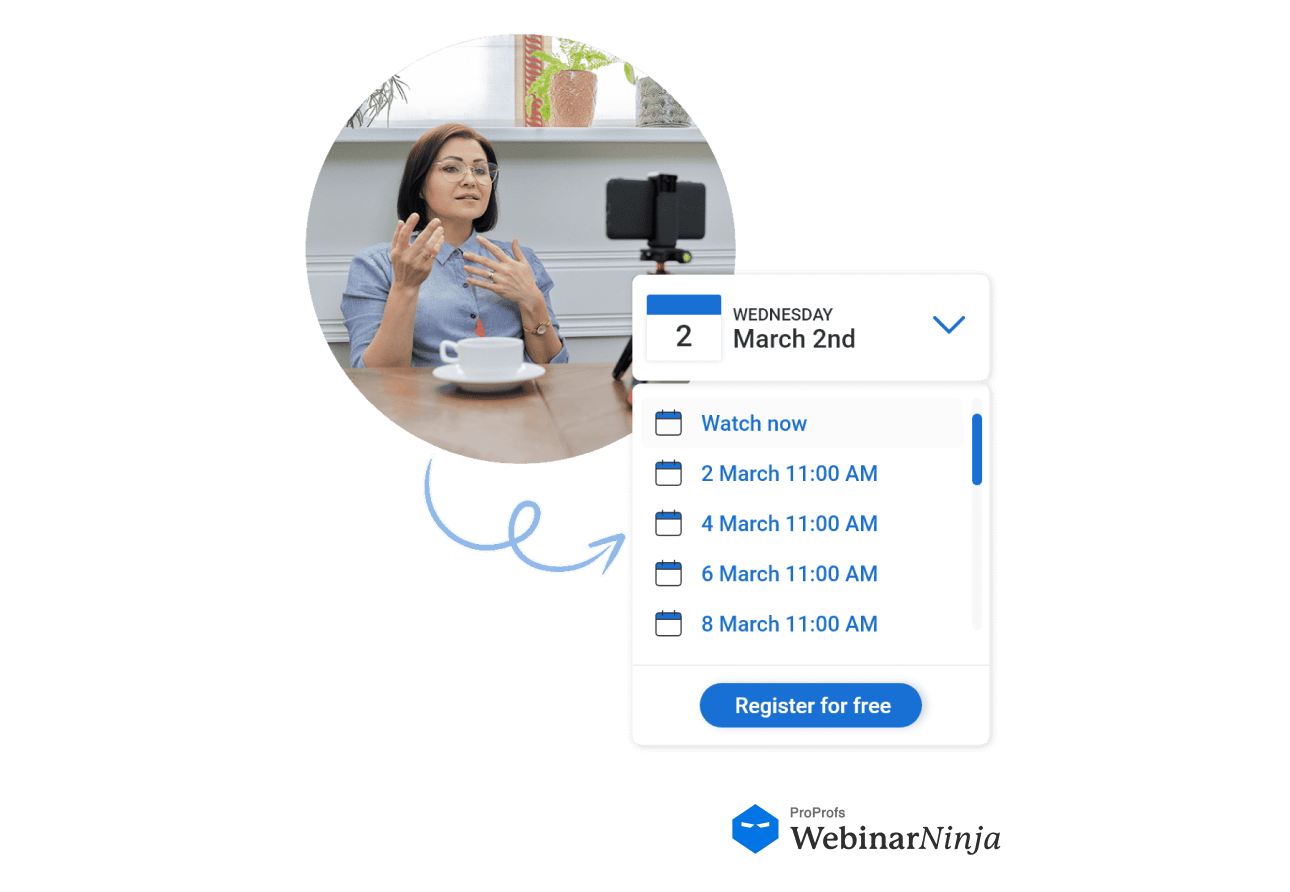
8. Lower Technical Risk
Pre-recorded webinars eliminate the possibility of technical glitches during live presentations, such as internet connectivity issues or unexpected disruptions.
9. Data Collection and Insights
Automated webinars can be paired with tools to gather valuable reports and analytics, such as view counts, drop-off points, and audience engagement metrics.
10. Reusability
The content can be repurposed for other formats, such as blog posts, social media snippets, or training materials.
What Are the Challenges With Pre-Recorded Webinars?
Pre-recorded webinars offer convenience and scalability but also come with specific challenges that can impact their effectiveness and reception. Here are some common challenges:
1. Lack of Real-Time Interaction
Viewers cannot ask questions or interact with the host in real-time, potentially reducing engagement and leaving queries unresolved.
Solution: Incorporate live Q&A sessions before or after the webinar or provide a discussion forum or email for follow-up questions.
2. Perceived Lack of Authenticity
Audiences might feel less connected to pre-recorded content, perceiving it as less genuine or engaging than live sessions.
Solution: Include elements like personal anecdotes, informal tone, or direct eye contact to create a sense of connection.
3. Limited Engagement
Without live polls, chats, or other interactive features, it can be harder to maintain viewer attention.
Solution: Add interactive elements like embedded quizzes, clickable content, or gamification to keep viewers engaged.
4. Technical Issues
Poor video or audio quality can distract viewers and reduce the webinar’s effectiveness.
Solution: Invest in quality recording equipment and test your setup thoroughly before recording.
5. Content Staleness
Pre-recorded webinars can become outdated, especially if they include data, trends, or references that change over time.
Solution: Periodically review and update the content to ensure it remains relevant.
6. Audience Drop-Off
Without the commitment of a live event, viewers may leave the webinar early or multitask during the session.
Solution: Keep the content concise and engaging, use storytelling techniques, and include calls to action to hold viewer interest.
7. Difficulty in Measuring Engagement
It’s harder to gauge audience reactions or adapt to their needs in a pre-recorded session.
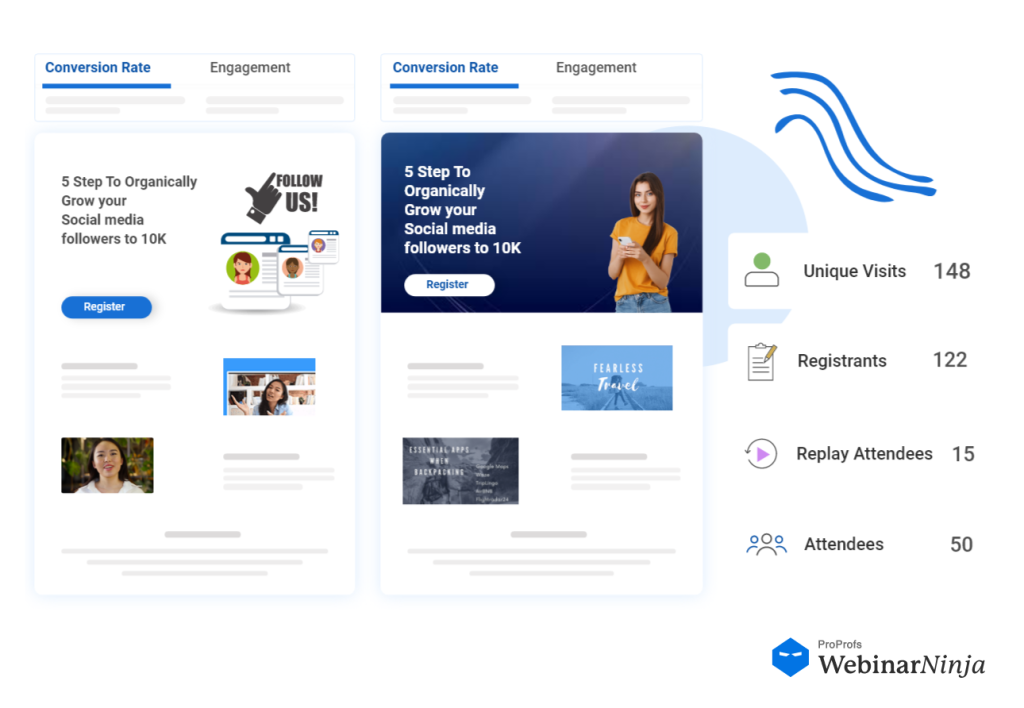
Solution: Use analytics tools to track viewer behavior, such as drop-off points and time spent on specific sections.
8. Marketing and Distribution
Getting people to attend a pre-recorded webinar can be challenging since it lacks the urgency of a live event.
Solution: Create a strong marketing strategy emphasizing the value of the content and offer on-demand access for flexibility.
9. Cost and Time Investment
Producing high-quality pre-recorded webinars requires an upfront investment in planning, recording, and editing.
Solution: Plan and script carefully to minimize retakes and consider outsourcing to professionals for a polished result.
10. Missed Networking Opportunities
Viewers miss out on the chance to network with other attendees or the presenter during live sessions.
Solution: Offer complementary live networking events or encourage viewers to join a community or group post-webinar.
Pre-Recorded vs. Live Webinars: The Differences
The main difference between live and pre-recorded webinars is their delivery and interaction.
Live webinars happen in real time with room for immediate interaction between instructors and learners through Q&A sessions, polls, and live feedback. This real-time engagement can enhance the learning experience, making it more dynamic and interactive.
On the other hand, pre-recorded webinars are recorded in advance so learners can access the content at their convenience. This format ensures consistency in content delivery and can be accessed repeatedly. While it lacks real-time interaction, it is more flexible for users with varying schedules.
Here are the key differences between the two webinars :
| Feature | Live Webinar | Pre-Recorded Webinar |
|---|---|---|
| Interactivity | High: Real-time interaction via Q&A, polls, and chat | Low: Interaction is limited to pre-set features |
| Flexibility | Limited: Happens at a specific time | High: Can be watched anytime |
| Audience Engagement | Dynamic: Tailored responses based on audience input | Static: Fixed content with no real-time adjustments |
| Technical Challenges | Higher risk of issues like connectivity or delays | Lower risk since it’s pre-edited and tested |
| Preparation Time | Moderate: Requires live facilitation and setup | High: Requires editing and post-production |
| Content Customization | Possible in real-time | Fixed once recorded |
| Reach | Limited by time zones and schedules | Global reach due to on-demand availability |
| Sense of Urgency | High: FOMO (fear of missing out) can drive attendance | Low: No urgency to watch immediately |
| Replay Availability | Optional: Recordings may or may not be shared | Always available for replay |
| Cost Efficiency | May require more resources for real-time management | Cost-effective over time as it can be reused |
| Best For | Time-sensitive, interactive, or high-engagement events | Evergreen content or presentations with less need for interaction |
Use Cases of Pre-Recorded Webinars
Pre-recorded webinars offer a flexible and powerful way to reach your audience and achieve your goals. Here’s how:
- Showcase Products With Ease: Create product demos that viewers can watch anytime, anywhere. This empowers potential customers to learn about your offerings at their convenience.
- Empower Your Customers: Educate customers on getting the most out of your products or services with pre-recorded webinars. This improves customer satisfaction and product adoption.
- Automate Sales and Nurture Leads: Use pre-recorded webinars to nurture leads and guide them through the sales funnel automatically. This frees up your sales team to focus on closing deals.
- Instant Access to Demos: Provide on-demand product demos for prospects who are eager to learn more. This shortens the sales cycle and keeps them engaged.
- Streamline Onboarding: Onboard new hires efficiently with consistent pre-recorded training webinars. This ensures everyone gets the same information and reduces onboarding time.
- Employee Training: Deliver ongoing training to your team using pre-recorded webinars. This guarantees all employees have access to the latest information and keeps your workforce skilled.
- Self-Paced Online Courses: They offer online courses that learners can take at their own pace, perfect for educational institutions and trainers. They cater to diverse learning styles and schedules.
- On-Demand Learning Resources: Provide on-demand guides through pre-recorded webinars for complex products or services. This empowers users to troubleshoot issues and learn advanced features independently.
- Efficient Customer Onboarding: Onboard large groups of customers with pre-recorded webinars. This ensures everyone receives the same introductory information consistently.
- Customer Support Resource Bank: Build a library of pre-recorded webinars as a customer support resource. This empowers customers to find answers to common questions and solve problems independently.
Best Practices for Marketing Pre-Recorded Webinars
Marketing pre-recorded webinars effectively involves a strategic blend of planning, targeting, and execution. Here are best practices to maximize their impact:
1. Focus on Quality Content
- Solve a Problem: Address a specific pain point or challenge your audience faces, providing actionable solutions they can implement.
- Engaging Presentation: Incorporate compelling visuals, dynamic transitions, and concise explanations to maintain viewers’ interest throughout.
- Evergreen Topics: Choose subjects with long-term relevance so the webinar remains valuable and can be reused over time.
2. Create a Compelling Title
- Highlight Benefits: Use action-oriented language to convey the webinar’s value clearly (e.g., “10 Proven Strategies to Boost Your Sales in 30 Days”).
- Incorporate Keywords: Optimize the title with keywords your audience is likely searching for to increase discoverability.
3. Optimize Landing Pages
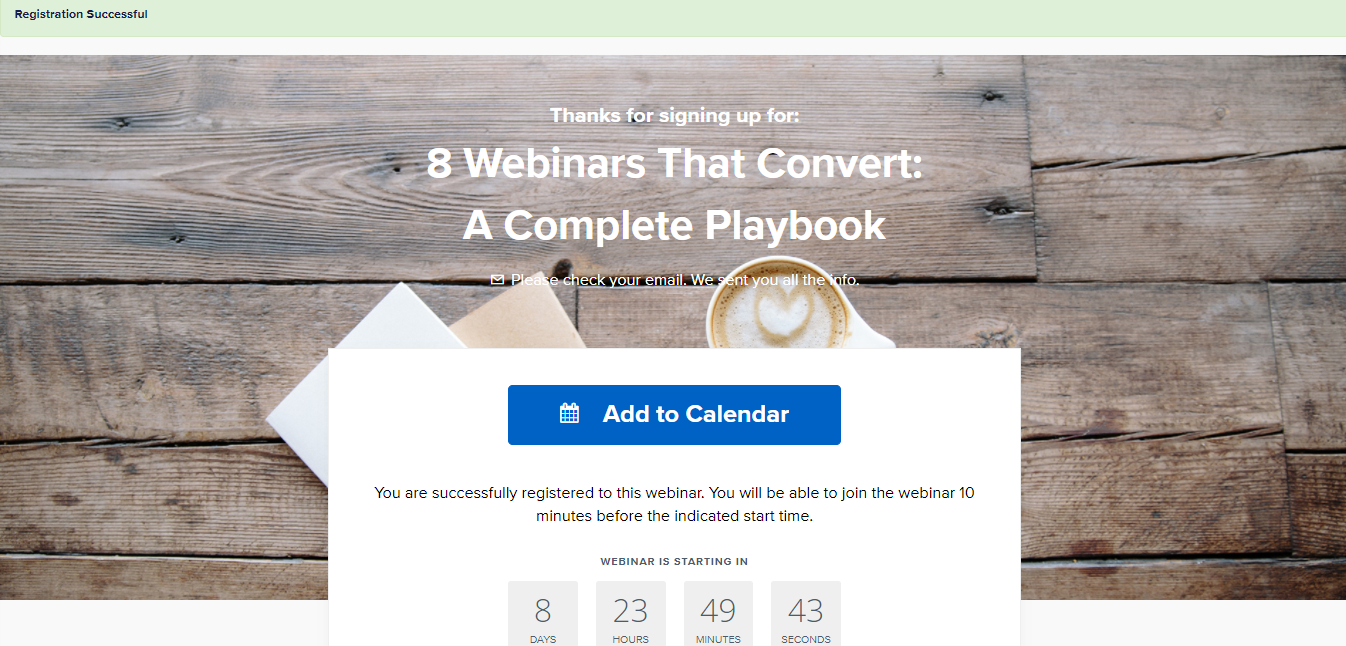
- Clear Value Proposition: Emphasize the unique benefits viewers will gain from the webinar, such as actionable takeaways or expert insights.
- Simple Signup Process: Keep the form short and easy, requesting only essential information like name and email to reduce friction.
- Engaging Visuals: Include attention-grabbing elements like a preview video, screenshots, or customer testimonials to build trust and interest.
4. Leverage Multi-Channel Promotion
- Email Marketing: Craft segmented, personalized invites with strong subject lines and clear calls-to-action to increase registration rates.
- Social Media Ads: Share teaser clips, quotes, or visuals from the webinar to generate excitement and target specific audiences.
- Collaborations: Partner with influencers, bloggers, or organizations that resonate with your target demographic to expand your reach.
5. Incorporate SEO Best Practices
- Keyword Optimization: Integrate relevant keywords in the webinar title, description, and metadata to improve search rankings.
- Supporting Content: Publish blog posts or summaries of the webinar that link to the replay, further driving traffic and engagement.
6. Offer On-Demand Access
- Emphasize Convenience: Highlight the flexibility of watching the webinar at any time, catering to busy schedules and different time zones.
- Analytics Integration: Use platforms that track user engagement, such as view duration and sections replayed, for deeper insights.
7. Use Automated Follow-Ups
- Target Non-Attendees: Send follow-up emails to registrants who missed the live webinar, providing a direct link to the on-demand version.
- Engage Attendees: Share additional resources like downloadable guides or a related blog post to keep the momentum going after the webinar.
8. Repurpose Webinar Content
- Short Clips: Create bite-sized videos featuring key highlights or interesting moments to share on platforms like Instagram or LinkedIn.
- Infographics: Design visual summaries of key takeaways, facts, or statistics for easy sharing and quick reference.
- Ebooks or Blogs: Expand on the webinar content to create downloadable resources that provide deeper insights or case studies.
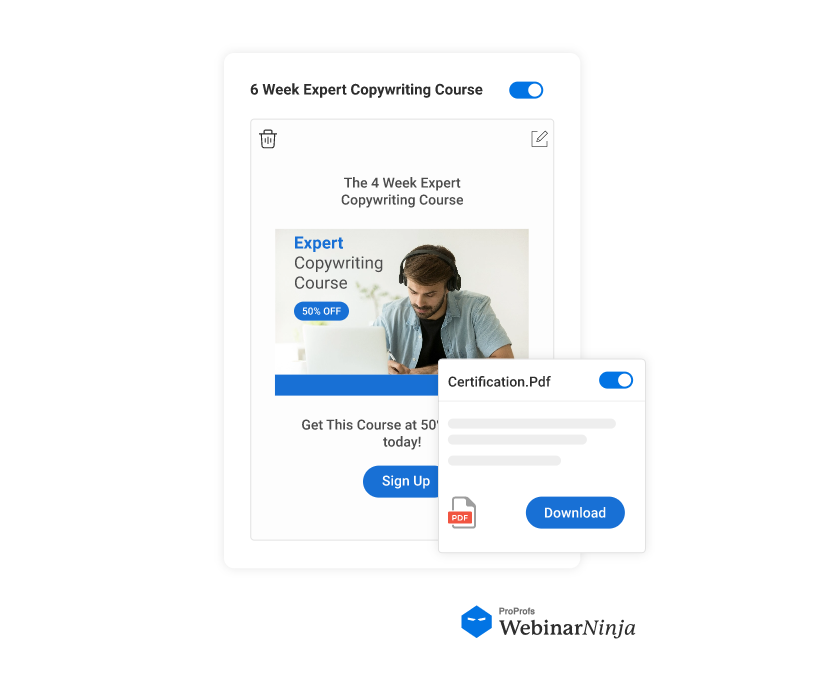
9. Include Interactive Elements
- Embedded Polls or Quizzes: Allow viewers to participate in real-time or simulated interactions during the webinar playback for a more engaging experience.
- Timestamps and Chapters: Help users quickly navigate to specific sections of the webinar, especially if they’re looking for particular topics.
10. Measure and Adjust
- Track Metrics: Use analytics tools to monitor key performance indicators like total views, watch duration, and conversion rates.
- Refine Based on Feedback: Identify areas where viewers drop off or lose interest to make improvements in future webinars, ensuring higher engagement.
Best Pre-Recorded Webinar Hosting Platforms
Here is a list of some of the best pre-recorded webinar platforms to create engaging content:
1. WebinarNinja
Best Webinar Software to Improve Marketing, Grow Sales, and Teach Better
I love WebinarNinja! It makes running webinars so much easier. As someone who focuses on delivering content, I hate getting bogged down by the technical side of things. WebinarNinja’s user-friendly interface takes care of all that.
WebinarNinja is the best pre-recorded webinar software for coaches, trainers, and educators. Its ease of use and affordable pricing make it a popular choice for delivering online courses with a mix of live and pre-recorded content.
Plus, it offers so much variety! Whether I want to do a live session, an automated one, or even a paid webinar, WebinarNinja has me covered. It even helps with the marketing side of things with built-in landing pages and email sequences.
WebinarNinja empowers you to keep your audience engaged with interactive features like live polls and open question lists.
WebinarNinja prioritizes what matters most: connecting with your audience. By streamlining the technical setup and execution of webinars, WebinarNinja enables users to focus on delivering exceptional content.
Pricing
A FREE 14-day trial available. Paid starts at $0.30/attendee/month (includes CourseNinja worth $1200).
2. Livestorm
Best for Virtual Events for Enterprise Needs
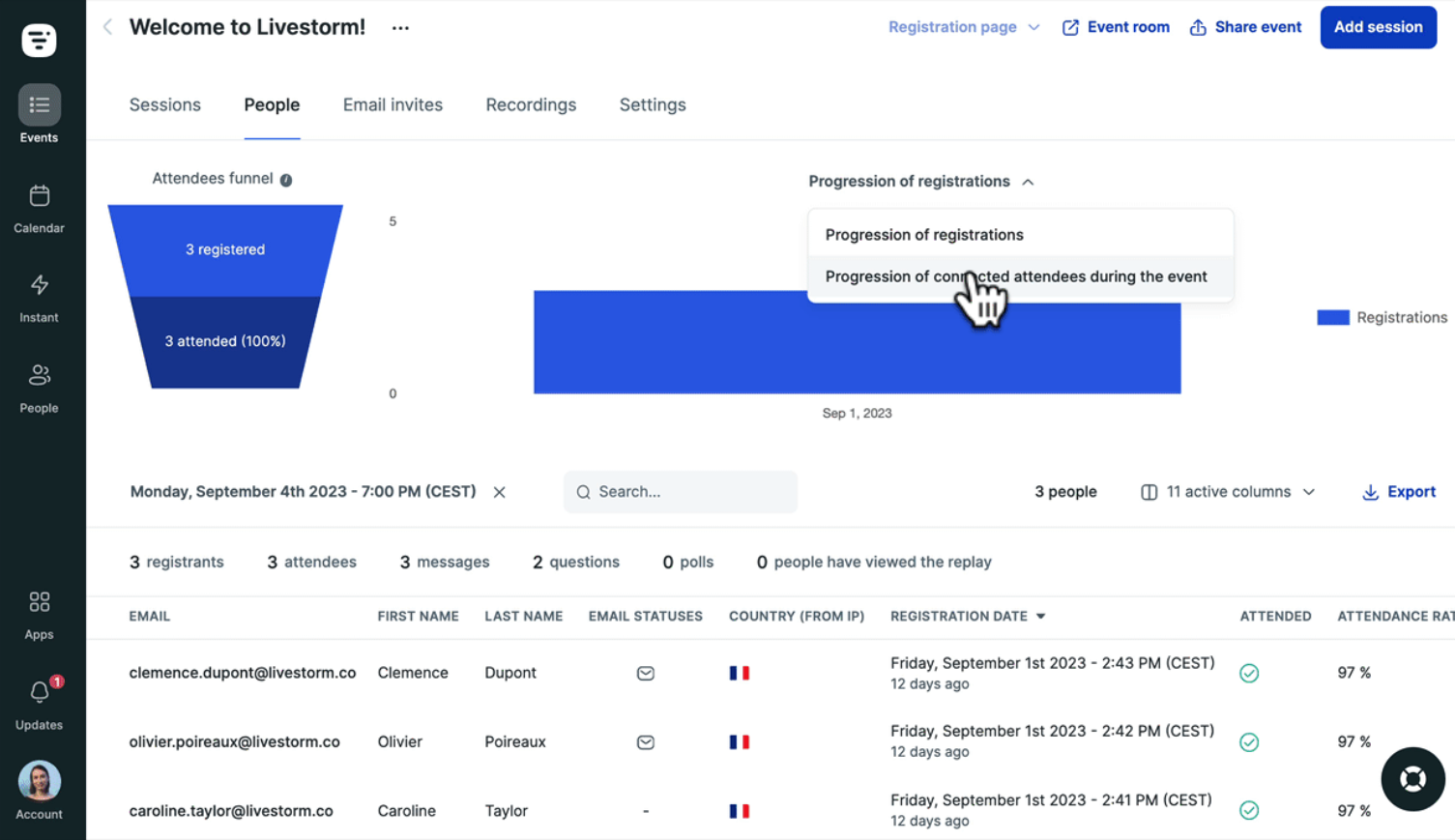
You know the struggle is real when you have to deliver high-impact virtual events. Setting everything up can be a time-consuming hassle that takes away from what truly matters: creating a professional and engaging experience for your audience.
Livestorm offers a comprehensive suite of features specifically designed to meet the needs of enterprises. Forget the pre-event scramble – Livestorm’s enterprise-grade video conferencing is ready to go at the click of a button.
But Livestorm goes beyond basic functionality. They understand that enterprises require a functional platform and exceptional support, so they provide VIP treatment with white-glove services.
This includes dedicated Customer Success Managers who become an extension of your team, personalized training to ensure you get the most out of the platform, and even executive business reviews to analyze your event performance and identify areas for improvement.
Pricing
Starts at $0 (Limited to 30 active contacts/month). Paid plan starts at $79/month.
3. Demio
Best for Webinar Engagement Analytics
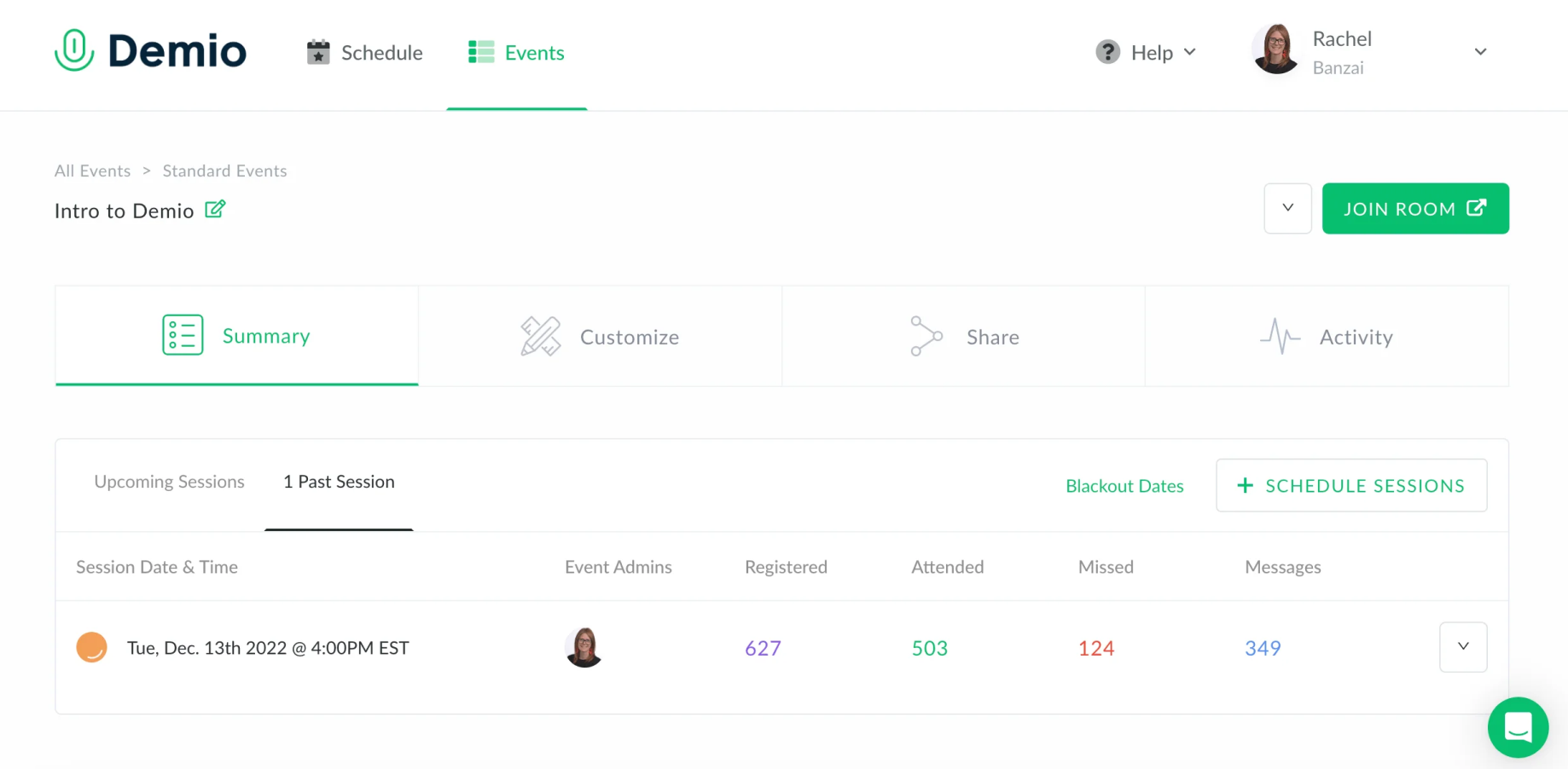
Now part of the Banzai family, Demio offers an ROI-driven webinar platform. Trusted globally, Demio helps users in marketing, sales, or customer success become pipeline heroes.
With Demio, you can analyze registrants, attendee engagement, and participation in polls and chats. This platform provides insights on attendee focus and drop-off points, helping you refine your strategy.
Demio’s analytics feature segments contacts and tracks registration origins, providing valuable data on channel success. Integrated UTM tracking in email notifications helps monitor marketing effectiveness. You can also export webinar data to merge with your CRM, driving engaged attendees further in their buying journey.
Users praise Demio for its reliability, user-friendly interface, and support team. It simplifies webinar hosting, allowing you to focus on content. Demio’s features, such as automated emails and event recordings, make it an essential tool for effective webinars and improved user experiences.
Pricing
Starts at $49/organizer/month
4. GoToWebinar
Best for Hosting Large-Scale Webinars with Meeting Software
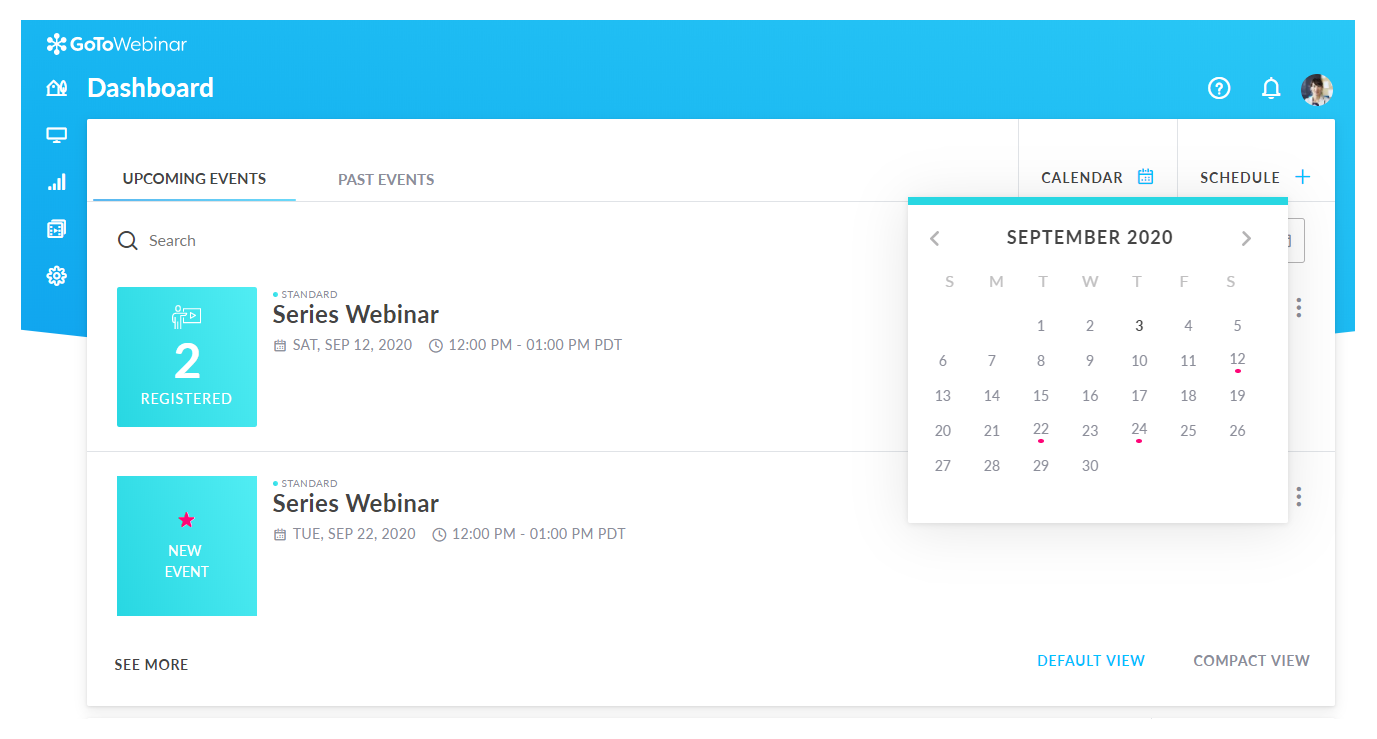
GoToWebinar offers a robust platform for hosting large-scale webinars. It supports events like remote employee training and full-scale conferences, which accommodate 3,000 attendees.
Participants can join webcasts directly from their browsers, eliminating the need for downloads. Enterprise-grade security protects both data and events.
The interactive features include HD video, clear audio, customizable registration forms, and tools for creating polls and quizzes, which help maintain high audience engagement. The platform also provides insightful analytics and powerful integrations for lead tracking and optimization of event strategy.
For monetization, GoToWebinar allows secure payment acceptance through Stripe and the option to host recorded webinars on GoToStage to attract a broader audience.
Pricing
Starts at $49/organizer /month
5. EasyWebinar
Best for Simple Automated Webinars
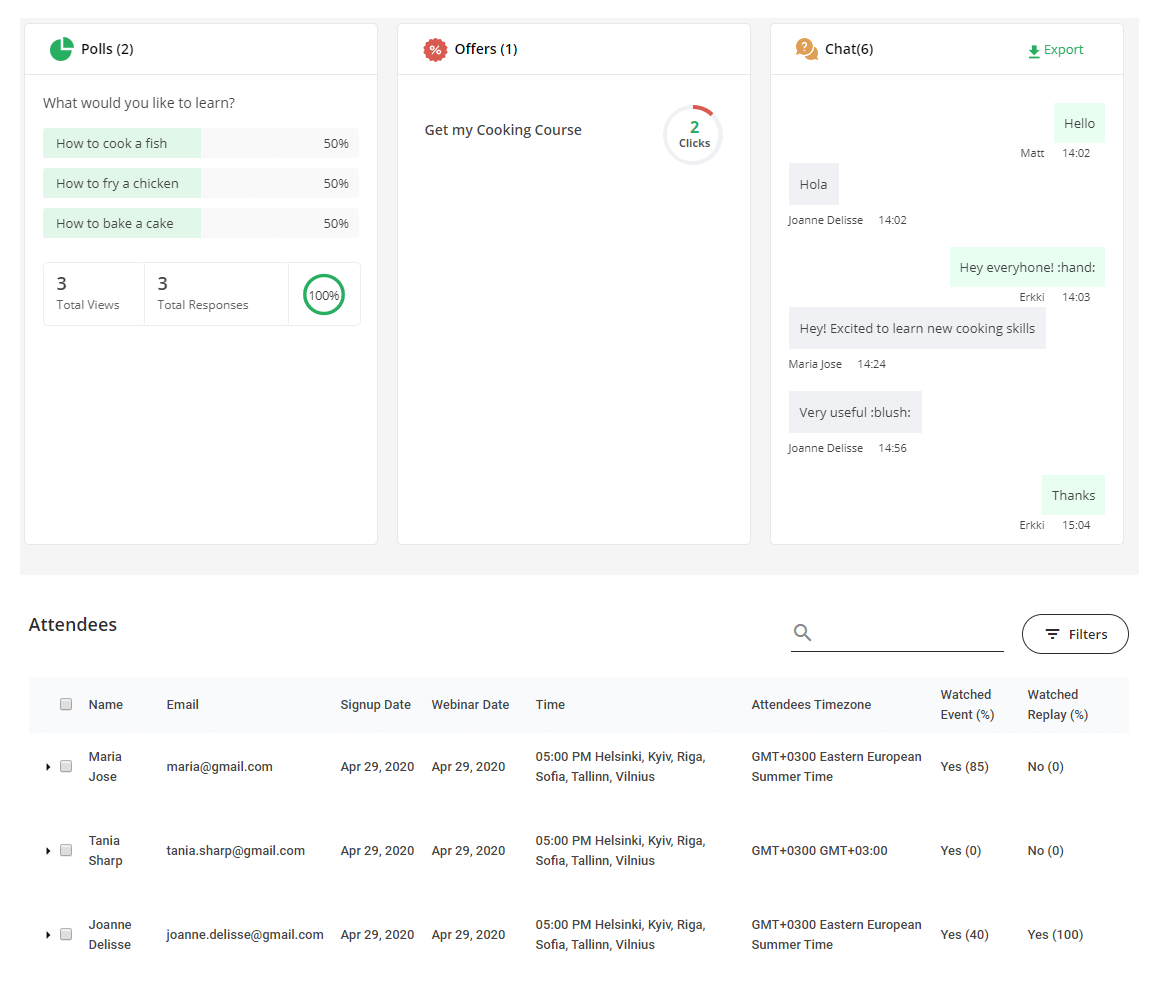
EasyWebinar is another best pre-recorded webinar software that helps with webinar management. With its automated webinar feature, you can convert live webinars into evergreen events that generate leads and customers around the clock. These webinars run without being date-specific, allowing you to focus on other tasks while your webinars work for you.
The platform mimics live event experiences through real-time streaming, creating a sense of urgency and commitment among viewers. It includes advanced analytics and reporting, helping you segment your audience and tailor your events.
Additional features like on-demand event access, dynamic “next available” sessions, and the ability to embed registration boxes on your web pages streamline the process.
EasyWebinar also integrates with social platforms like Facebook and YouTube through EasyCast, expanding your reach. With customizable webinar pages, built-in email notifications, and third-party tracking pixel integration, EasyWebinar provides a comprehensive solution to boost your business.
Pricing
Free plan available (limited to 10 attendees). Starts at $80/host
How to Measure the Success of Pre-Recorded Webinars
While you learned how to host a pre-recorded webinar, assessing their impact and returns is one of the most crucial aspects.
Measuring pre-recorded webinars’ success involves evaluating quantitative and qualitative metrics to understand their impact and effectiveness. Here are key methods and metrics to consider:
1. Engagement Metrics
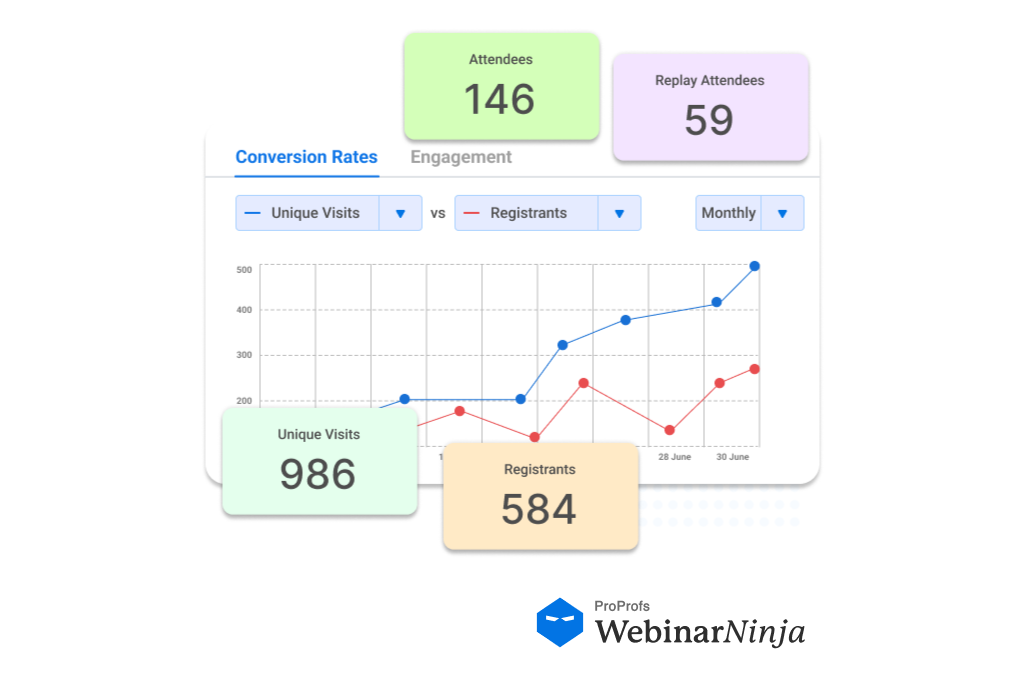
- Attendance Rates: Compare the number of registrants to actual viewers. A high attendance rate indicates effective promotion and interest.
- Watch Time: Analyze how long viewers watch the webinar. High retention suggests engaging content, while drop-off points can indicate areas for improvement.
- Repeat Views: Measure how often people revisit the webinar. Frequent replays can signal value and relevance.
- Interaction Metrics: Track activities like:
- Questions asked during live Q&A (if hybrid).
- Poll or survey participation.
- Resource downloads (e.g., PDFs, links).
2. Conversion Metrics
- Lead Generation: Count the number of new leads generated from the webinar.
- Sales/Revenue: Measure purchases or revenue directly linked to the webinar using tracking links, promo codes, or follow-up surveys.
- Call-to-Action (CTA) Success: Evaluate how many viewers completed desired actions, such as signing up for a service, booking a consultation, or subscribing to a newsletter.
3. Marketing Metrics
- Traffic Sources: Analyze where attendees are coming from (e.g., email campaigns, social media, website).
- Registration Rates: Assess the effectiveness of promotional campaigns by comparing the number of webinar registrations to impressions or clicks.
- Audience Demographics: Review attendee information (job roles, industries, locations) to ensure alignment with your target audience.
4. Feedback and Satisfaction
- Post-Webinar Surveys: Collect qualitative feedback through surveys about the content, format, and overall experience.
- Net Promoter Score (NPS): Ask participants how likely they are to recommend the webinar to others.
- Social Media Mentions/Reviews: Monitor social media for feedback or user-generated content related to the webinar.
5. ROI Analysis
- Cost vs. Benefit: Calculate the total cost of producing and promoting the webinar against the monetary and non-monetary gains (e.g., new leads, partnerships).
- Customer Lifetime Value (CLV): For customers acquired through the webinar, estimate their long-term value to your business.
6. Retention and Post-Webinar Activity
- Follow-Up Engagement: Track how many attendees engage with post-webinar follow-ups like emails, blogs, or additional content.
- Community Growth: Measure growth in followers, subscribers, or group members after the webinar.
Ready to Create Your First Pre-Recorded Webinar?
A pre-recorded webinar offers a range of benefits: flexibility, wider reach, and evergreen content.
It’s your opportunity to connect, educate, and drive results without the constraints of time zones or live hosting. With careful planning and the right tools, success is just a few clicks away.
But how do you tap into this goldmine?
You can use a good webinar tool like WebinarNinja that simplifies the process with features like automated scheduling, seamless editing, and intuitive interfaces. The robust platform helps you design, upload, and share pre-recorded webinars effortlessly, ensuring a professional experience for you and your audience every step of the way.
Want to host a webinar for free?
Use WebinarNinja to teach, improve marketing, and grow your sales.




